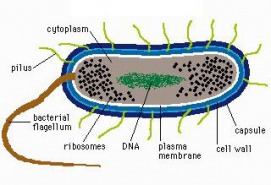All About Viruses and Bacteria
Bacteria Reproduction

Structure
Bacteria reproduce a lot differently than viruses. They are able to reproduce on their own unlike viruses. To understand how viruses do this though you need to understand what bacteria is made of and how it is composed. Bacteria first have a cell wall. The cell wall protects the bacteria form its environment, like your skin would do for you. It also has a cell membrane. The cell membrane controls what goes in and out of the cell including water and food. Bacteria don't have a nucleus, so its genetic material (DNA) is floating around in its cytoplasm. Some bacteria have flagella. A bacteria cell can have one or many flagella. They are used for moving around in its environment, but not all bacteria have them. If a bacterium does not have flagella it relies on things like water, air, or even you. The pili are located on the outside of the cell. They are made of protein and are used for attaching the cell to other cells. This is useful in things like reproduction. Inside the cytoplasm you can also find the ribosome. These are like tiny factories in the cell. They produce proteins for the cells. That is basically how a bacteria cell is composed.
Now to how a bacteria cell actually reproduces. It reproduces in two basic ways. One is sexual reproduction and the other asexual reproduction. Each is different in many ways. Asexual reproduction involves only one bacteria cell or parent. The cell uses binary fission to create an exact copy of it's self. It first copies its DNA. The cell then stretches itself and forces the cell membrane to grow inward toward the center of the cell. The cell membrane continues to grow until the cell is separated into two different identical cells. That is how asexual reproduction works in bacteria. Asexual reproduction is used when bacteria need large number of the same bacteria with no adaptations. They can use asexual reproduction to quickly colonize an area or environment. Below is an illustration of asexual reproduction and the official names of the different steps, or phases.
Now to how a bacteria cell actually reproduces. It reproduces in two basic ways. One is sexual reproduction and the other asexual reproduction. Each is different in many ways. Asexual reproduction involves only one bacteria cell or parent. The cell uses binary fission to create an exact copy of it's self. It first copies its DNA. The cell then stretches itself and forces the cell membrane to grow inward toward the center of the cell. The cell membrane continues to grow until the cell is separated into two different identical cells. That is how asexual reproduction works in bacteria. Asexual reproduction is used when bacteria need large number of the same bacteria with no adaptations. They can use asexual reproduction to quickly colonize an area or environment. Below is an illustration of asexual reproduction and the official names of the different steps, or phases.
The other type of bacteria reproduction is sexual reproduction. This requires two bacteria or parent cells. This process requires two bacteria to pair and share DNA. This will result in a better and adapted parent cells. The two bacteria then go through the process of asexual reproduction like before, but now with shared DNA from both cells. Going through this process will result is a new bacteria that is the same as its adapted parent cell. Sexual reproduction results in a strong bacterium that is more resistant to antibiotics and harder to kill. This process though takes more time than asexual reproduction, so is not as affective when infecting a person with an illness or disease.

